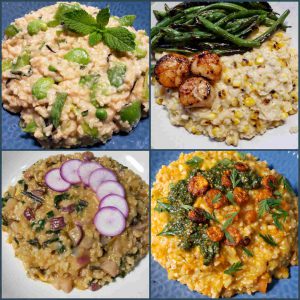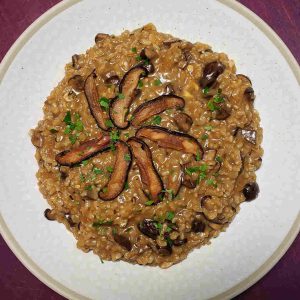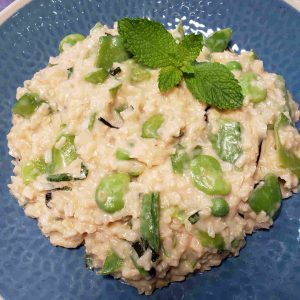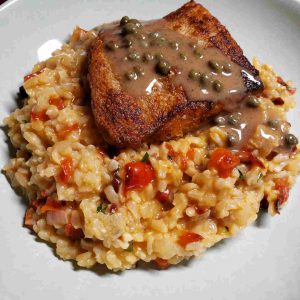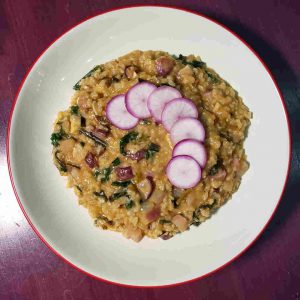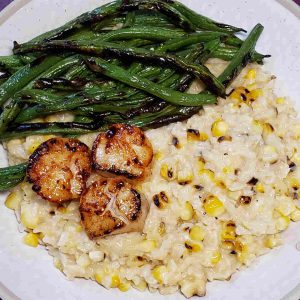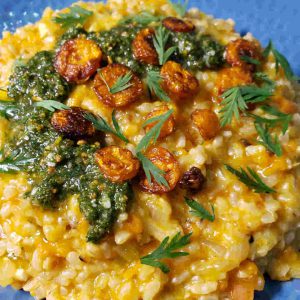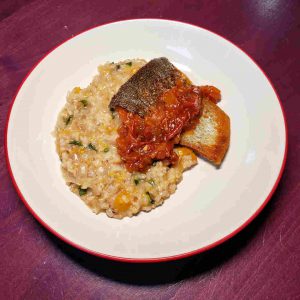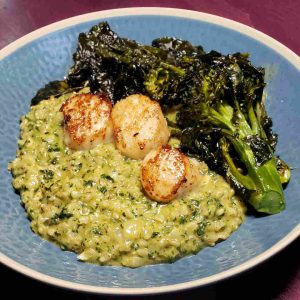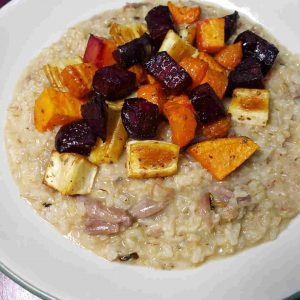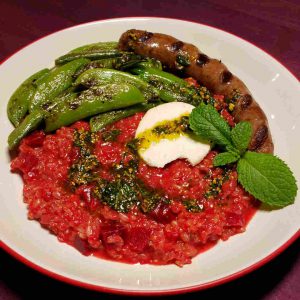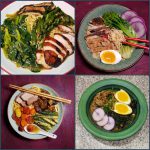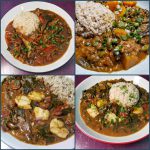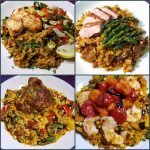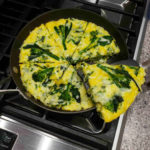If you haven’t read it yet, I recommend you first read my About Risotto post, and then come back here for the mother dish technique.
The Elements
The Star Ingredient
Risotto is a true mother dish. A single dish that can use whatever is fresh and seasonal. I can go to our local farmers’ market, which only offers products from a 50-mile radius, and select a star ingredient at the peak of its season. The star ingredient should shine as the star it is. At the same time, the dish must be a risotto displaying al dente rice in a creamy sauce with the nuances of aromatics and delicate cheeses. Sometimes there is more than a single star ingredient. Sometimes they can costar in pairs, such as butternut squash and kale. Sometimes costars can be plated with the risotto to turn it into a one dish meal, such as pan seared flounder on top of a caramelized red pepper risotto.
Short Grain Brown Rice
Risotto requires a starchy rice. The starches are coaxed out of the rice and lend to the creaminess of the final dish. Generally short grain rice has the most starch while long grain rice has the least and medium grain rice is, of course, in the middle. Hence you want to use a short grain brown rice for this risotto. You can seek out a traditional risotto variety, such as Arborio, in an unprocessed brown form, but I simply use the organic short grain brown rice from the grocery’s bulk bin.
Aromatics
Most often, the aromatics I use for risotto are simply onions and garlic. For brighter dishes, such as risotto with snap peas and fava beans, I only soften the onions without browning them. For more deep and earthy dishes, such as mushroom risotto, I allow the onions to gently brown, which adds a rich caramel nuance to the dish.
Liquids
In risotto, the rice absorbs the flavors of the liquids in which it is poached. This usually starts with a splash of white wine to deglaze the pan after sautéing the aromatics and adding the rice. The main liquid is stock. Usually, you want a relatively neutral stock such as chicken or vegetable Sometimes there can be reason to use a more assertive stock such as a shrimp stock when making a seafood risotto or duck stock when making a risotto using duck confit. Sometimes wine can take a larger role. I’ve seen recipes that call for 2 cups of red wine to be used along with a broth. I’ve also made, and enjoy as an alternative, risotto which leverages marsala, using ¾ of a cup during poaching, and another ¼ cup in the finishing.
Finishing Cheese
I finish my risotto with 3 tablespoons of butter and 2 ounces of cheese- Parmesan being the go-to standard. However switching up the cheese can add a lot of character to the final dish. Select a finishing cheese that complements the star of the dish. For example, a tangy fresh goat cheese pairs nicely with peas and mint or with fire-roasted corn. Or a funky taleggio pairs well with earthy produce such as baby turnips and greens, mushrooms or stinging nettles. And, you can likely find local cheeses to use in the risotto at market where you picked up the star of the dish.
Special Equipment
This oven assisted brown risotto method requires a small, enameled cast iron Dutch oven. I use the 3 quart size from Lodge and am jealous of those who use the 3.5 quart size from Le Creuset.
Cook-ins, Mix-ins and Toppings
One consideration that you need to make with respect to your star ingredient(s) is whether they will be cooked in or mixed in. Cooked in means they will poach in the stock along with the rice. Mixed in means they are cooked separately and mixed together at the end. Cooked in is very convenient and often the way I go. Mixed in allows you to use other cooking techniques on the star ingredients. For example, roasting root vegetables endues them with rich, complex flavors. Sautéing mushrooms allows you to brown them. A quick blanching of greens keeps their colors vibrant. If you choose to cook in, the ingredients bring their water to the poach, so lessen the stock.
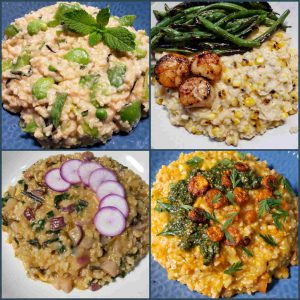
Risotto – The Mother Dish Technique
Equipment
- This oven assisted brown risotto method requires a small, enameled cast iron Dutch oven in the 3 to 3.5 quart range.
Ingredients
Ingredients
- 1 Tbsp olive oil
- 1 medium yellow onion (about 6-8 oz) chopped
- a few cloves of garlic minced
- 4-5 cups broth or stock divided
- 2-3 oz wine
- 1.5 cups short grain brown rice
- The right amount of the star ingredient(s) see notes below
- 2 oz finishing cheese grated if it’s a hard cheese
- 3 Tbsp unsalted butter cut into a dozen cubes or pats
- Salt and pepper to taste
- Other seasonings and garnishes optional
Instructions
Steps
- Pre-heat the oven to 375 degrees F.
- Sauté the diced onions in the olive oil and a pinch of salt, over medium heat in a medium sized enameled Dutch oven. You are either going for delicate, soft, and translucent, or a little bit brown and caramelly, depending on the star ingredient. About 2 minutes before you think the onions will be ready, add the garlic and sauté another couple minutes.
- Add the brown rice to the pot and stir to coat each grain with the aromatic infused oil.
- Add the splash of wine to deglaze any fond that has developed and stir until the wine has mostly been absorbed by the rice.
- If you are cooking in the star ingredient, add it now along with some broth. If there is a substantial amount of that ingredient, add 3 cups of broth. Otherwise, add 4 cups of broth.
- Increase the heat to high and bring the pot to a full boil. As things are heating, taste test for seasoning. It should need some salt at this point, but how much depends on the how salty your selected broth is. At this point the broth should be well-seasoned. If your finishing cheese is a salty variety, such as an aged Parmesan, go for just under well-seasoned.
- Once a full boil is reached, cover the pot and transfer to the 375 degree oven, where it will gently simmer for 50 minutes.
- At this point you have plenty of time to prepare any mix-in ingredients, accompaniments, and garnishes.
- After 50 minutes, remove the pot from the oven, open it and give it a quick stir. Expect the rice to be fully cooked and properly hydrated, but no residual liquid. Depending on many variables you may not find that to be true. If the rice is underhydrated (i.e. crunchy), it will take more time (and more liquid if there is no residual liquid at this point). If there is residual liquid, it just means that you will add less broth during finishing.
- To finish, stir in the pats of butter then the mix-ins (if any), then 1 cup of broth. The cheese is stirred in last. Parmesan cheese can turn stringy if it is over-stirred, and risotto is all about creamy and should never be stringy! One last taste test for seasoning. Stir in a bit more salt only if it needs it.
- Finally, plate, add garnishes and accompaniments, and enjoy!
Notes
- If it’s a chopped ingredient, about 1 lb
- If it’s leafy greens, 6-8 oz
- If it’s a mix, you have to wing it a bit

